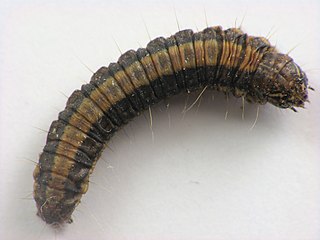Prussian Blue was an American white nationalist, Neo-Nazi pop duo formed of Lynx Vaughan Gaede and Lamb Lennon Gaede, fraternal twins born on June 30, 1992, in Bakersfield, California. The duo Prussian Blue was formed in early 2003 by their mother April Gaede. The twins referred to the Holocaust as a myth and promoted Holocaust denial and their group was described as racist and white supremacist.

Malacosoma castrense, the ground lackey, is a moth of the family Lasiocampidae. It is a tent caterpillar found in Europe. The species was first described by Carl Linnaeus in his 1758 10th edition of Systema Naturae.

Callidrepana is a genus of moths belonging to the subfamily Drepaninae.
Guillermo "Bill" Gaede is an Argentine engineer and programmer who is best known for Cold War industrial spying conducted while he worked at Advanced Micro Devices (AMD) and Intel Corporation (Intel). While at AMD, he provided the Cuban government with technical information from the semiconductor industry which the Cubans passed on to the Soviet bloc, primarily to the Soviet Union and East Germany. In 1992, Gaede turned himself over to the Central Intelligence Agency (CIA), which placed him in contact with the Federal Bureau of Investigation (FBI). The FBI began working with Gaede in a counter-espionage operation intended to penetrate Cuban intelligence using his contacts on the island. During this time Gaede obtained work at Intel Corp. in Chandler, Arizona. Intel Security discovered the nature of his activities at AMD and terminated him, but not before Gaede filmed Intel's state-of-the-art Pentium process from home.
Adisura bella is a species of moth of the family Noctuidae first described by Max Gaede in 1915. It is found in Africa, including South Africa, Somalia, Tanzania and Saudi Arabia
Max Gaede was a German engineer and entomologist of international fame who described several hundred of new species of Lepidoptera, mainly African Noctuidae.

The Epipaschiinae are a subfamily of snout moths. Almost 600 species are known today, which are found mainly in the tropics and subtropics. Some occur in temperate regions, but the subfamily is apparently completely absent from Europe, at least as native species. A few Epipaschiinae are crop pests that may occasionally become economically significant.

Aethalopteryx is a genus of moths belonging to the family Cossidae.

Armee-Abteilung Gaede / Armee-Abteilung B was an army level command of the German Army in World War I. It served on the Western Front throughout its existence and formed the extreme left wing.
Nausinoe reussi is a species of moth of the family Crambidae described by Max Gaede in 1917. It can be found in Tanzania, in eastern Africa.
Sijua is a genus of moths of the family Thyrididae from Africa.
Sijua jejunalis is a species of moth of the family Thyrididae. It is found in the small African nation of Togo.
Sijua plagalis is a species of moth of the family Thyrididae. It is found in Cameroon.
Nemea betousalis is a species of moth of the family Thyrididae. It is found in Kenya.

Phiala is a genus of moths in the family Eupterotidae.
Lebedodes is a genus of moths in the family Cossidae.

Metarbela is a genus of moths in the family Cossidae described by William Jacob Holland in 1893.





